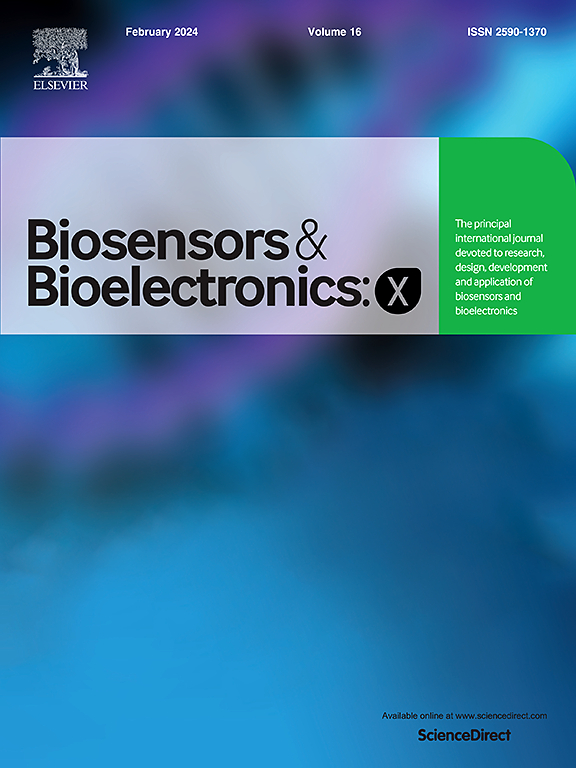Design and fabrication of smartphone based single paper lateral flow assay for early detection of PCOS biomarker
IF 10.61
Q3 Biochemistry, Genetics and Molecular Biology
引用次数: 0
Abstract
Polycystic Ovary Syndrome (PCOS) is a multifactorial endocrine disorder with significant diagnostic challenges, especially in early stages. Current diagnostic methods are often complex, time-consuming, and dependent on laboratory-based infrastructure. This study presents the design and fabrication of a smartphone-assisted paper-based lateral flow assay (LFA) for the early detection of PCOS via the quantification of sex hormone-binding globulin (SHBG), a promising metabolic biomarker. Fluorescent nitrogen-doped carbon dots (CDs) were synthesized using a microwave-assisted method and conjugated with anti-SHBG antibodies via EDC/NHS chemistry. The LFA strips were constructed using Whatman filter paper, and hydrophobic barriers were drawn using permanent marker ink. A portable device equipped with a 365 nm UV LED and a smartphone camera enabled fluorescence detection. Recombinant SHBG antigen samples in phosphate-buffered saline (PBS) were tested across a concentration range of 80–4000 ng/mL. The system exhibited a strong linear response (R2 = 0.9677) between SHBG concentration and fluorescence intensity, with a calculated limit of detection (LOD) and limit of quantification (LOQ) of 2.68 ng/mL and 19.93 ng/mL, respectively. The analytical range of 80–4000 ng/mL corresponds to 0.8–42.1 nmol/L, covers the clinical diagnostic threshold of SHBG (<36 nmol/L). These results demonstrate the feasibility of a low-cost, point-of-care diagnostic tool for early PCOS screening. Further validation with clinical samples is necessary for real-world deployment.
基于智能手机的PCOS生物标志物早期检测单纸侧流法的设计与制作
多囊卵巢综合征(PCOS)是一种多因素内分泌疾病,具有显著的诊断挑战,特别是在早期。目前的诊断方法往往复杂、耗时,并且依赖于实验室基础设施。本研究介绍了一种智能手机辅助的基于纸张的横向流动试验(LFA)的设计和制造,通过定量性激素结合球蛋白(SHBG),一种有前途的代谢生物标志物,用于PCOS的早期检测。采用微波辅助法制备了荧光氮掺杂碳点(CDs),并通过EDC/NHS化学与抗shbg抗体偶联。使用Whatman滤纸构建LFA条带,并使用永久标记墨水绘制疏水屏障。配备365纳米紫外LED和智能手机摄像头的便携式设备可以进行荧光检测。重组SHBG抗原样品在磷酸盐缓冲盐水(PBS)中测试,浓度范围为80-4000 ng/mL。该体系SHBG浓度与荧光强度呈良好的线性关系(R2 = 0.9677),计算出的检测限(LOD)和定量限(LOQ)分别为2.68 ng/mL和19.93 ng/mL。80 ~ 4000 ng/mL的分析范围对应0.8 ~ 42.1 nmol/L,达到SHBG的临床诊断阈值(36 nmol/L)。这些结果证明了一种低成本、即时诊断的多囊卵巢综合征早期筛查工具的可行性。在实际应用中,需要对临床样本进行进一步验证。
本文章由计算机程序翻译,如有差异,请以英文原文为准。
求助全文
约1分钟内获得全文
求助全文
来源期刊

Biosensors and Bioelectronics: X
Biochemistry, Genetics and Molecular Biology-Biophysics
CiteScore
4.60
自引率
0.00%
发文量
166
审稿时长
54 days
期刊介绍:
Biosensors and Bioelectronics: X, an open-access companion journal of Biosensors and Bioelectronics, boasts a 2020 Impact Factor of 10.61 (Journal Citation Reports, Clarivate Analytics 2021). Offering authors the opportunity to share their innovative work freely and globally, Biosensors and Bioelectronics: X aims to be a timely and permanent source of information. The journal publishes original research papers, review articles, communications, editorial highlights, perspectives, opinions, and commentaries at the intersection of technological advancements and high-impact applications. Manuscripts submitted to Biosensors and Bioelectronics: X are assessed based on originality and innovation in technology development or applications, aligning with the journal's goal to cater to a broad audience interested in this dynamic field.
 求助内容:
求助内容: 应助结果提醒方式:
应助结果提醒方式:


